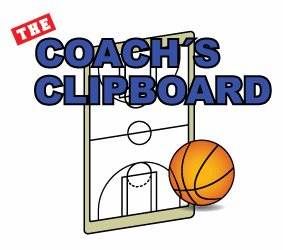Basketball Offense - 4-Out, 1-In Motion Offense
By Dr. James Gels, from the Coach's Clipboard Basketball PlaybookSee more comments...
Disclosure: This page contains affiliate links, which means that Coach's Clipboard receives a small commission (at no cost to you) if you make a purchase using these links.

See Motion Offense Principles. This motion offense uses four perimeter players and one post player, and is good to use when your team has good outside players and only a few post players. Generally we run the 4-out motion offense against man-to-man defenses. However, you can use the 4-out, 1-in set as a zone offense, although the rules are different (see 4-Out, 1-In Zone Offense).
Teams at all levels use the 4-out offense. At the collegiate level, while widely used by many teams, specifically Jay Wright at Villanova has had a lot of success with it.

Former Villanova Coach Jay Wright
You can use the 4-out offense to post up any of your players inside, if you feel there is a defensive mismatch. For example, if a defensive player has 4 fouls, have your player that he is guarding post up inside. Then get the ball inside to him/her and draw that 5th foul, or get an easy basket (since the defender has to be careful). You can change the inside player by calling out "4-Out to John", where John becomes the inside post player.
The 4-out offense can be as complicated or as simple as you want. Youth teams should start out with the basic 4-out motion offense, learning the motion rules and "how to play". You can add a few simple plays. High school and more advanced level teams can expand the basic 4-out motion offense, and add the "4-High" and "4-Low" sets. Both sets come with a number of plays and options.
We do not use all of these plays in one season. We pick plays that best suit our current team's personnel. Next season, as our players change, we may select other plays and options. Don't overload your players by teaching too much at once. Teach the basic motion and sets, and then add plays and options later.
Coach Jay Wright does it a little differently than from what is described below, and was very successful with two NCAA national championships (2016, 2018). Rather than 4 guards, he uses 3 guards and two bigger forwards. The two forwards play opposite each other, so that one is always high in a slot at the top of the arc, and the other is low inside. So he has a 4-out set while still using two interchangeable "bigs". See Jay Wright's 4-Out Offense
"4-Out"
This is a more simple, free-lance style of 4-out motion offense that uses the rules explained below. Four perimeter players space out on the 3-point arc. There is one post player, who starts either low or high (free throw line area). The post player moves as the ball moves, using the low blocks, anywhere up and down the lanes, paint area, elbows and high post (free-throw line area) - basically anywhere he/she can get open for a pass inside.When the ball is on top, O5 could locate at high-post, ball-side elbow area. From this spot, O5 could set a ball-screen for a pick and roll play. Or if the ball is passed to O5 at the high post, the wing players could back-cut to the hoop for a pass from O5.
When the ball is on the low wing, corner area, then O5 moves down to the ball-side low post.
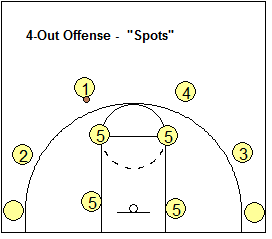
General Rules
Perimeter Spots and Movement.
Perimeter players fill any of the six spots shown in the diagram above, two top spots, two wing spots, and two corner spots. Perimeter players move, fill open spots, pass and cut, and screen for each other (ball-screen and screen away).
Hand-off weave screens work well. For example, O1 dribbles toward O2, hands the ball off to O2 while screening O2's defender. O2 comes around the screen and either shoots the 3-pointer, or dribble-drives inside (see Weave-Screen Plays).
Dribble-penetration.
Perimeter players can attack with a dribble-drive. This is often easier when the post player is located on the opposite (weakside) low block. Drive and kick - if you have good 3-point shooters, you can go "inside-out" where a guard dribble-penetrates, draws in the helpside defenders, and then kicks the pass out to a perimeter player spotting up for a 3-point shot.
Pick and roll and give and go plays work.
4 things you can do after passing:
Rules without the ball:
Set PlaysPerimeter players fill any of the six spots shown in the diagram above, two top spots, two wing spots, and two corner spots. Perimeter players move, fill open spots, pass and cut, and screen for each other (ball-screen and screen away).
Hand-off weave screens work well. For example, O1 dribbles toward O2, hands the ball off to O2 while screening O2's defender. O2 comes around the screen and either shoots the 3-pointer, or dribble-drives inside (see Weave-Screen Plays).
Dribble-penetration.
Perimeter players can attack with a dribble-drive. This is often easier when the post player is located on the opposite (weakside) low block. Drive and kick - if you have good 3-point shooters, you can go "inside-out" where a guard dribble-penetrates, draws in the helpside defenders, and then kicks the pass out to a perimeter player spotting up for a 3-point shot.
Pick and roll and give and go plays work.
4 things you can do after passing:
- Ball-screen.
- Screen away.
- Cut to the basket (example: give and go, or back-cut). Backcut if the defender is denying the pass.
- V-cut and pop back outside for the return pass and outside shot.
Rules without the ball:
- If you have an under-play (defender sagging off), pop out to spread the defense.
- If you have an overplay (being denied), backcut.
- Someone dribbling at you, backcut (except for the weave plays).
- Fill the open spot when a teammate cuts inside.
- When someone dribble-penetrates, relocate.
- Screen away, and pop out.
- The most important rule is to keep moving.
You can run any of the set plays listed below under the 4-High and 4-Low sets - just make sure the post player starts in the correct spot.
"4-High" Motion Offense
In "4-High" our post player is at the high post. This takes his/her defender away from the hoop and allows him/her to attack 1-on-1. This also opens up the inside underneath for backcuts and dribble-penetration from the wings and corners. The high post player can also be used for UCLA (high post) screens, "pinch-post" hand-offs, back-screens for perimeter players, and ball-screen pick and roll action.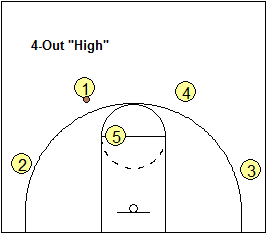
When the high post player screens for a perimeter player, and the defense switches the screen, a big-little size mis-match may occur. Now our post player goes inside to post up.
Additionally, certain plays run better off the 4-High set. 4-High works well against teams that like to full-front the low post. With our post player at the high post, if still full-fronted, he/she seals the defender, and cuts to the hoop for an over-the-top lob pass. Also the post player seals the defender if the pass goes to the corner, and then cuts to the hoop for the pass from the corner.
See these: 4-High Set Plays - "Topside", "Counter", "Flash", "Jet-Back", "Slip", "Swing", "Fist", and the Weave-Screen Plays ("W2", W2-back", "W3", "W4").
Transition into 4-Out Offense
After a defensive rebound, the wings O2 and O3 sprint wide up the court to the corners. Going deep into the corners opens the court with better spacing. For a wing entry pass, the corner player can cut up to the wing for the pass. The first "big" up the court sprints low in the paint or low block area. O1 speed-dribbles up the court and our rebounder (here O4) trails and fills the opposite top spot.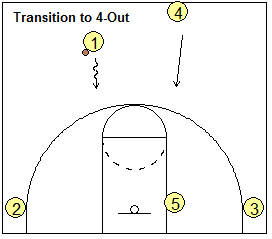
From here we have lots of options. If our point guard is good at attacking the defender, he/she might make a dribble-move and attack the seam up the right lane line for a lay-up, or for a kick-out pass to O2 in the corner. We can also start the offense here in the "4-Low" set. To start the "4-High" set, O5 flashes up to the high post. We could also start a quick hitter play here.
"4-Low"
In "4-Low" our post player stays low, moving from low block to low block, or from short-corner to short-corner. The 4-Low set opens up the top and the lane for 1-on-1 dribble-penetration and cuts from the top. We also use this set to run our "Big" series of plays, where we post-up our "big" 1-on-1.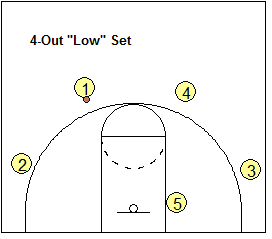
The short-corner to short-corner strategy is used if there is a big, strong post defender, a shot blocker, that our post player cannot consistently beat in a low block 1-on-1 post-up situation. If our post player can hit a couple shots from the short-corner, this will draw the big defender away from the hoop. Getting the shot-blocker away from the hoop allows our smaller, quick post player to beat the defender with a shot-fake and dribble move.
See these: 4-Low Set Plays - "Big Series", "Loyola" plays, "53", "34", "13" and "24", "Black", "52-Curl", "14", "Florida", "Scissors", "Purdue", "Penn", "Double", and the Weave-Screen Plays ("W2", W2-back", "W3", "W4").Counters for Low Post Double-Team
Teams that play good man-to-man defense, often double-team our low post player, making it tough to score inside. Usually the double-team (help defender) comes from the opposite wing when we feed the low post from the wing or corner (diagram B). There are a couple things you can do.- Feed the low post from the top ("hi-lo" plays like the "Big" series). When the ball is at the top, the helpside defense is not established (diagram A below), and low post has a 1-on-1 situation.
- After a pass to the low post from the wing, the post player O5 gets double-teamed usually by help coming from the opposite wing (diagram B). O5 immediately skip passes out to the opposite wing (where the help defender came from), and then follows the pass and re-posts on the opposite side, for the quick pass back inside (from O4 in diagram C). Often the new helpside defender (X2) is late in rotating over to double-team, and O5 now has X5 1-on-1.
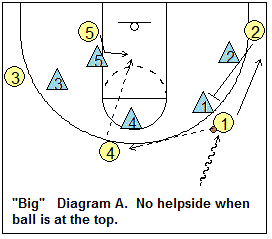
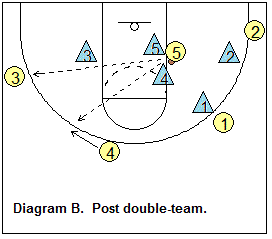
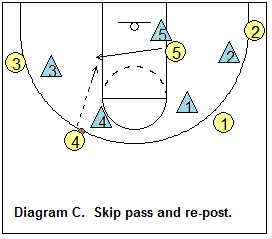
See these: Quick Hitters for the 4-Out Offense - "45", "Wing Entry Ball-screen", "Wing Entry - Left", "Gator", "High", "Runner", "Duke", "Curl and Flare Option", "Flex Option", and "Back-Screen Lob Option".
More Reading on the 4-Out Motion Offense
- Jay Wright's 4-Out Offense
- How to Use Your Post Player in the 4-Out Offense
- Quick Hitters for the 4-Out Offense
- 4-Out, 1-In Motion Offense "High" Plays
- 4-Out, 1-In Motion Offense "Low" Plays
- 4-Out Zone Offense
- Slice Motion Offense
- Simple Slam Motion Offense
- Motion Offense Screening Drills
Jay Wright: (from "Breakdown Drills for the 4-Out-1-In Motion Offense")
Andrew Grantz: (from "4-Out 1-In Attack and React Motion Offense")
Andrew Grantz: (from "4-Out 1-In Attack and React Motion Offense")
